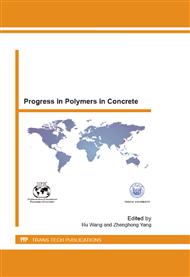[1]
L. Czarnecki, M.H. Ozkul, Polymer-Concrete Composites, C-PC: Drivers and Research Area in the Light of Aspic 2012, Proc. of the 7th ASPIC, Istanbul 2012, pp.89-94
Google Scholar
[2]
J.B. Aguiar, M.H. Ozkul, S. Cunha, Report from 13th ICPIC and 7th ASPIC: New Trends on Concrete-Polymer Composites, Proc. of the 14th ICPIC, Shanghai, (2013)
DOI: 10.4028/www.scientific.net/amr.687.45
Google Scholar
[3]
The toolbox for change – a practical approach. Identifying driving forces. www.billsynnotandassociates.com
Google Scholar
[4]
A. Zimmerman, The Driving Forces of Change and How You Can Master Them. www.trans4mind.com
Google Scholar
[5]
F. van Houten, What are the global driving forces and how they influence production. Our common future, Hannover, (2010)
Google Scholar
[6]
Y. Ohama, Recent progress in research and development activities of concrete-polymers composites in Japan, Proceedings of X International Congress on Polymers in Concrete, Hawaii (2001)
Google Scholar
[7]
K. L. Scrivener, R. J. Kirkaptric, Innovation in use and research on cementitious material, Cement and Concrete Research. 38 (2008) 128-136
DOI: 10.1016/j.cemconres.2007.09.025
Google Scholar
[8]
L. Czarnecki, Sustainable Concrete; Is Nanotechnology the Future of Concrete Polymer Composites, Proc. of the 14th ICPIC, Shanghai, (2013)
Google Scholar
[9]
D. Van Gemert, Synergies between polymers and cement concrete providing opportunities for sustainable construction, Proc. of the 14th ICPIC, Shanghai, (2013)
DOI: 10.4028/www.scientific.net/amr.687.12
Google Scholar
[10]
A. J. Bement Jr: Prosperity cycle, NSF, USA, (2009)
Google Scholar
[11]
M. Gunasekaran, Jobs, Prosperity and World Peace through Polymer Concrete, Proc. of the 14th ICPIC, Shanghai, (2013)
Google Scholar
[12]
D.W. Fowler, Application of PC and PMC in Industry and Industrial Environment, Proc. of the 14th ICPIC, Shanghai, (2013)
Google Scholar
[13]
D. van Gemert, A. Beeldens, Evolution in Modelling Cement Hydration and Polymer Hardening in Polymer-Cement Concret, Proc. of the 14th ICPIC, Shanghai, (2013)
DOI: 10.4028/www.scientific.net/amr.687.291
Google Scholar
[14]
E. Knapen, D. van Gemert, Cement hydration and microstructure formation in the presence of water-soluble polymers, Cement and Concrete Research. 1 (2007) 6-13
DOI: 10.1016/j.cemconres.2008.10.003
Google Scholar
[15]
R. Wang, X. Shi, P. Wang, Recent Research on Polymer-modified Cement Mortar in China, Proc. of the 14th ICPIC, Shanghai, (2013)
Google Scholar
[16]
Z. Sun, D. Ye, L. Fu, B. Zheng, Z. Feng, M. Chen, Properties of Polyacrylic Ester Latex Modified Cement Mortar, Proc. of the 14th ICPIC, Shanghai, (2013)
DOI: 10.4028/www.scientific.net/amr.687.166
Google Scholar
[17]
D.A.S. Sclofani, L. Contrafattol, Experimental Behaviour of Polyvinyl-Alcohol Modified Concrete, Proc. of the 14th ICPIC, Shanghai, (2013)
Google Scholar
[18]
J. Pakusch, S.X. Wang, S. Iyer, Polymers for Concrete Modification – Interactions and Application, Proc. of the 14th ICPIC, Shanghai, (2013)
Google Scholar
[19]
T. Pavlitschek, Y. Jin, J. Plank, Film Formation of a Non-iconic Ethylene-Vinyl Acetate Latex Dispersion in Cement Pore Solution, Proc. of the 14th ICPIC, Shanghai, (2013)
DOI: 10.4028/www.scientific.net/amr.687.316
Google Scholar
[20]
T. Pavlitschek, M. Gretz, J. Plank, Effect of Ca2+ Ions on the Film Formation of an Anionic Styrene n-Butylacrylate Latexpolymer in Cement Pore Solution, Proc. of the 14th ICPIC, Shanghai, (2013)
DOI: 10.4028/www.scientific.net/amr.687.322
Google Scholar
[21]
H. Zhu, P. Wang, G. Zhang, R. Wang, Effects of Redispersible EVA and E/VL/VC Powders on Properties of Decorative Mortar, Proc. of the 14th ICPIC, Shanghai, (2013)
DOI: 10.4028/www.scientific.net/amr.687.241
Google Scholar
[22]
S. Zhong, D. Han, J. Li, Some Aspects about Absorption of Polymer on Cement Grain, Proc. of the 14th ICPIC, Shanghai, (2013)
Google Scholar
[23]
I. Ion, J.B. Aguiar, N. Angelescu, D. Stanciu, Properties of Polymer Modified Concrete in Fresh and Hardened State, Proc. of the 14th ICPIC, Shanghai, (2013)
DOI: 10.4028/www.scientific.net/amr.687.204
Google Scholar
[24]
X. Yue, R. Wang, Influence of SBR Latex on the Formation of C-S-H in C3S Paste, Proc. of the 14th ICPIC, Shanghai, (2013)
Google Scholar
[25]
X. Shi, R. Wang, Dispersion and Absorption of SBR Latex in the System of Monodispersed Cement Particles in Water, Proc. of the 14th ICPIC, Shanghai, (2013)
Google Scholar
[26]
H. He, Y. Cui, M. Shi, Thermodynamics of the Polymer-Concrete Interface, Proc. of the 14th ICPIC, Shanghai, (2013)
Google Scholar
[27]
B. Chmielewska, Effect of Polymer Additive on Gas Permeability Coefficient of Concrete, Proc. of the 14th ICPIC, Shanghai, (2013)
Google Scholar
[28]
A. Diming-Osburg, Innovations based on PCC, Proc. of the 14th ICPIC, Shanghai, (2013)
Google Scholar
[29]
J. Ping Lu, Review on Application of Polymer Concrete in Singapore, Proc. of the 14th ICPIC, Shanghai, (2013)
Google Scholar


